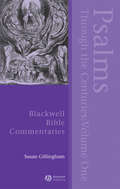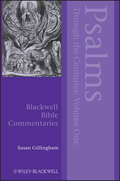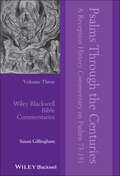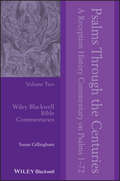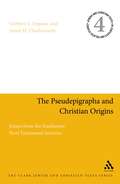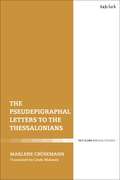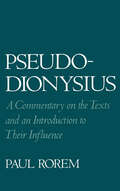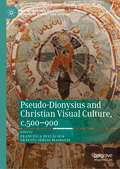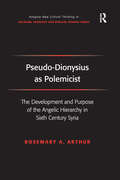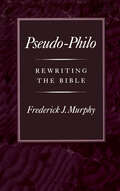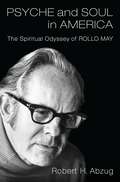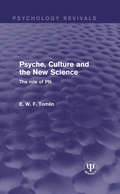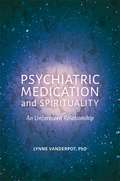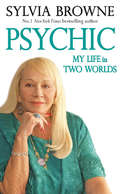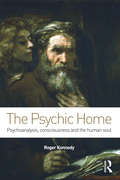- Table View
- List View
Psalms Through the Centuries (Wiley Blackwell Bible Commentaries #36)
by Susan GillinghamThis is the first of a two-volume bible commentary covering the Psalms and examining the role of these biblical poems throughout Jewish and Christian history. Provides a fascinating introduction to the literary, historical, and theological background of psalmody Examines the psalms through liturgy and prayer, study and preaching, translation and imitation, and musical composition and artistic illustration Includes illustrations of significant psalms, helpful maps, and an extensive bibliography; an expanded bibliography to accompany the book is also available at www.wiley.com/go/gillingham A forthcoming second volume is planned, which will take an alternative psalm-by-psalm approach Now available in paperback, and published in the innovative reception-history series, Blackwell Bible Commentaries
Psalms Through the Centuries (Wiley Blackwell Bible Commentaries)
by Susan GillinghamThis is the first of a two-volume bible commentary covering the Psalms and examining the role of these biblical poems throughout Jewish and Christian history. Provides a fascinating introduction to the literary, historical, and theological background of psalmody Examines the psalms through liturgy and prayer, study and preaching, translation and imitation, and musical composition and artistic illustration Includes illustrations of significant psalms, helpful maps, and an extensive bibliography; an expanded bibliography to accompany the book is also available at www.wiley.com/go/gillingham A forthcoming second volume is planned, which will take an alternative psalm-by-psalm approach Now available in paperback, and published in the innovative reception-history series, Blackwell Bible Commentaries
Psalms Through the Centuries, Volume 3: A Reception History Commentary on Psalms 73 - 151 (Wiley Blackwell Bible Commentaries #36)
by Susan GillinghamThis third volume completes the set of a groundbreaking reception history of the Psalter, the culmination of two decades’ work In Volume Three of Psalms Through the Centuries: A Reception History Commentary on Psalms 73-151, the internationally recognized biblical scholar Professor Susan Gillingham examines the Jewish and Christian cultural and reception history of Books Three to Five of the Psalter. She examines the changing ways in which psalms have been understood in translations and commentaries, liturgy and prayer, study and preaching, music and art, poetic and dramatic performance, and political and ethical discourse. Lavishly illustrated with thirty colour plates, several black and white images and a number of musical scores, this volume also includes a comprehensive glossary of terms for readers less familiar with the subject and a full, selective bibliography complete with footnote references for each psalm. Numerous links to website resources also allow readers to pursue topics at greater depth, and three clearly organized indices facilitate searches by specific psalms or authors, or types of reception for selected psalms. This structure makes the commentary easy to use, whether for private study, teaching or preaching. The book also offers: A one-of-a-kind treatment of the reception history of the psalms that starts where most commentaries end— beginning with the trajectory of the Psalter’s multi-faceted reception over two millennia Specific discussions of both Jewish and Christian responses to individual psalmsPsalms Through the Centuries: A Reception History Commentary on Psalms 73-151, like the previous two volumes, will earn a distinctive place in the libraries of faculties, colleges, seminaries, and religious communities as well as in private collections of students and scholars of biblical studies, theology, and religion.
Psalms Through the Centuries, Volume 3: A Reception History Commentary on Psalms 73 - 151 (Wiley Blackwell Bible Commentaries)
by Susan GillinghamThis third volume completes the set of a groundbreaking reception history of the Psalter, the culmination of two decades’ work In Volume Three of Psalms Through the Centuries: A Reception History Commentary on Psalms 73-151, the internationally recognized biblical scholar Professor Susan Gillingham examines the Jewish and Christian cultural and reception history of Books Three to Five of the Psalter. She examines the changing ways in which psalms have been understood in translations and commentaries, liturgy and prayer, study and preaching, music and art, poetic and dramatic performance, and political and ethical discourse. Lavishly illustrated with thirty colour plates, several black and white images and a number of musical scores, this volume also includes a comprehensive glossary of terms for readers less familiar with the subject and a full, selective bibliography complete with footnote references for each psalm. Numerous links to website resources also allow readers to pursue topics at greater depth, and three clearly organized indices facilitate searches by specific psalms or authors, or types of reception for selected psalms. This structure makes the commentary easy to use, whether for private study, teaching or preaching. The book also offers: A one-of-a-kind treatment of the reception history of the psalms that starts where most commentaries end— beginning with the trajectory of the Psalter’s multi-faceted reception over two millennia Specific discussions of both Jewish and Christian responses to individual psalmsPsalms Through the Centuries: A Reception History Commentary on Psalms 73-151, like the previous two volumes, will earn a distinctive place in the libraries of faculties, colleges, seminaries, and religious communities as well as in private collections of students and scholars of biblical studies, theology, and religion.
Psalms Through the Centuries, Volume Two (Wiley Blackwell Bible Commentaries #36)
by Susan GillinghamPsalms Through the Centuries: Volume Two provides the first ever extensive commentary on the Jewish and Christian reception history of the first two books of the Psalter (Psalms 1-41 and 42-72). It explores the various uses of the Psalms, over two millennia, in translation and commentary, liturgy and prayer, study and preaching, musical composition and artistic illustration, poetic and dramatic imitation, and contemporary discourse. With lavish illustrations, using examples from both music and art, Psalms Through the Centuries: Volume Two offers a detailed commentary on each psalm, with an extensive bibliography, a large glossary of terms, and helpful indices. It is an ideal resource both for students and scholars in the academy and for lay people and ministers in church and synagogue. Psalms Through the Centuries is published within the Wiley Blackwell Commentary series. Further information about this innovative reception history series is available at www.bbibcomm.info
Psalms Through the Centuries, Volume Two (Wiley Blackwell Bible Commentaries)
by Susan GillinghamPsalms Through the Centuries: Volume Two provides the first ever extensive commentary on the Jewish and Christian reception history of the first two books of the Psalter (Psalms 1-41 and 42-72). It explores the various uses of the Psalms, over two millennia, in translation and commentary, liturgy and prayer, study and preaching, musical composition and artistic illustration, poetic and dramatic imitation, and contemporary discourse. With lavish illustrations, using examples from both music and art, Psalms Through the Centuries: Volume Two offers a detailed commentary on each psalm, with an extensive bibliography, a large glossary of terms, and helpful indices. It is an ideal resource both for students and scholars in the academy and for lay people and ministers in church and synagogue. Psalms Through the Centuries is published within the Wiley Blackwell Commentary series. Further information about this innovative reception history series is available at www.bbibcomm.info
The Pseudepigrapha and Christian Origins: Essays from the Studiorum Novi Testamenti Societas (Jewish and Christian Texts)
by James H. Charlesworth Gerbern S. OegemaIn the Seminar "The Pseudepigrapha and Christian Origins" of the "Studiorum Novi Testamenti Societas", chaired from 2000 to 2006 by Professors James H. Charlesworth (Princeton) and Gerbern S. Oegema (McGill), the relation between the Pseudepigrapha and the New Testament has been discussed systematically and intensively in a way never seen before. The Pseudepigrapha investigated included the Old Testament ones and those found in the Qumran as well as the Pseudepigrapha of the New Testament and the ones used in the Early Church. The seminar and its participants, who were all internally renowned experts from around the world, have focused on the use, adaptation, reinterpretation and further development of non-canonical traditions (except for Philo, Josephus, the Essene and early Rabbinic writings) in the canonical writings of Early Christianity. The seminar has met in total five times in various locations, while systematically being arranged around the following topics: The Pseudepigrapha and the Synoptic Gospels, the Gospel of John, the Epistles of Paul, the Other New Testament Writings, and the Revelation of John.
The Pseudepigrapha and Christian Origins: Essays from the Studiorum Novi Testamenti Societas (Jewish and Christian Texts #4)
by James H. Charlesworth Gerbern S. OegemaIn the Seminar "The Pseudepigrapha and Christian Origins" of the "Studiorum Novi Testamenti Societas", chaired from 2000 to 2006 by Professors James H. Charlesworth (Princeton) and Gerbern S. Oegema (McGill), the relation between the Pseudepigrapha and the New Testament has been discussed systematically and intensively in a way never seen before. The Pseudepigrapha investigated included the Old Testament ones and those found in the Qumran as well as the Pseudepigrapha of the New Testament and the ones used in the Early Church. The seminar and its participants, who were all internally renowned experts from around the world, have focused on the use, adaptation, reinterpretation and further development of non-canonical traditions (except for Philo, Josephus, the Essene and early Rabbinic writings) in the canonical writings of Early Christianity. The seminar has met in total five times in various locations, while systematically being arranged around the following topics: The Pseudepigrapha and the Synoptic Gospels, the Gospel of John, the Epistles of Paul, the Other New Testament Writings, and the Revelation of John.
The Pseudepigraphal Letters to the Thessalonians
by Marlene CrüsemannMarlene Crüsemann examines the Thessalonian letters in the context of Jewish-Christian social history; building upon her analysis of 1 Thessalonians, Crüsemann comes to the conclusion that it is post-apostolic epistolary communication, and questions whether it is a letter of Paul and indeed whether it is an early letter. This analysis in turn adds weight to the thesis, propounded by some previous scholars, that the letter is somewhat out of place and may be a later work by another author. Crüsemann subsequently illustrates that 2 Thessalonians, by contrast, revokes the far-reaching social separation from Judaism that characterizes 1 Thessalonians, and thus aims socio-historically at a solidarity with the entire Jewish people. Analysing the concept of the Jews as supposed enemy, the future of the Greek gentile community, and the relationship between the two letters, Crüsemann concludes that the discussion about a "divergence of the ways of Christians and Jews" in early Christian times needs to be realigned.
The Pseudepigraphal Letters to the Thessalonians
by Marlene CrüsemannMarlene Crüsemann examines the Thessalonian letters in the context of Jewish-Christian social history; building upon her analysis of 1 Thessalonians, Crüsemann comes to the conclusion that it is post-apostolic epistolary communication, and questions whether it is a letter of Paul and indeed whether it is an early letter. This analysis in turn adds weight to the thesis, propounded by some previous scholars, that the letter is somewhat out of place and may be a later work by another author. Crüsemann subsequently illustrates that 2 Thessalonians, by contrast, revokes the far-reaching social separation from Judaism that characterizes 1 Thessalonians, and thus aims socio-historically at a solidarity with the entire Jewish people. Analysing the concept of the Jews as supposed enemy, the future of the Greek gentile community, and the relationship between the two letters, Crüsemann concludes that the discussion about a "divergence of the ways of Christians and Jews" in early Christian times needs to be realigned.
Pseudo-Dionysius: A Commentary on the Texts and an Introduction to Their Influence
by Paul Rorem"Dionysius the Areopagite" is the biblical name chosen by the pseudonymous author of an influential body of Christian theological texts, dating from around 500 C.E. The Celestial Hierarchy, The Ecclesiastical Hierarchy, The Divine Names, and The Mystical Theology offer a synthesis of biblical interpretation, liturgical spirituality, and Neoplatonic philosophy. Their central motif, which has made them the charter of Christian mysticism, is the upward progress of the soul toward God through the spiritual interpretation of the Bible and the liturgy. Dionysius continually reminds his readers, however, that all human concepts fall short of the transcendence of God and must therefore be abandoned in negotiations and silence. In this book, Rorem provides a commentary on all of the Dionysian writings, chapter by chapter, and examines especially their complex inner coherence. The Dionysian influence on medieval theology is introduced in essays on specific topics: hierarchy, biblical symbolism, angels, Gothic architecture, liturgical allegory, the scholastic doctrine of God, and the mystical theology of the western Middle Ages. Rorem's book makes these texts more accessible to both scholars and students and includes a comprehensive bibliography of secondary sources.
Pseudo-Dionysius and Christian Visual Culture, c.500–900 (New Approaches to Byzantine History and Culture)
by Francesca Dell’Acqua Ernesto Sergio MainoldiThis book uses Pseudo-Dionysius and his mystic theology to explore attitudes and beliefs about images in the early medieval West and Byzantium. Composed in the early sixth century, the Corpus Dionysiacum, the collection of texts transmitted under the name of Dionysius the Areopagite, developed a number of themes which have a predominantly visual and spatial dimension. Pseudo-Dionysius’ contribution to the development of Christian visual culture, visual thinking and figural art-making are examined in this book to systematically investigate his long-lasting legacy and influence. The contributors embrace religious studies, philosophy, theology, art, and architectural history, to consider the depth of the interaction between the Corpus Dionysiacum and various aspects of contemporary Byzantine and western cultures, including ecclesiastical and lay power, politics, religion, and art.
Pseudo-Dionysius as Polemicist: The Development and Purpose of the Angelic Hierarchy in Sixth Century Syria (Routledge New Critical Thinking in Religion, Theology and Biblical Studies)
by Rosemary A. ArthurThe anonymous theologian known as Pseudo-Dionysius, who was responsible for arranging the angelic hierarchy into nine orders, had a significant influence on mediaeval European mysticism. This book places him in his religious and political context in sixth century Syria, and uncovers the hidden agenda which lies behind his writings. New evidence is presented to establish the dating of the corpus more accurately than has been done before. Rather than analysing the minutiae of Dionysius' thought, Rosemary Arthur focuses on his sources for, and treatment of, the Angelic Hierarchy and the Dazzling Darkness, with a view to ascertaining his motive for writing, his relationship with his opponents and his need to hide his identity.
Pseudo-Dionysius as Polemicist: The Development and Purpose of the Angelic Hierarchy in Sixth Century Syria (Routledge New Critical Thinking in Religion, Theology and Biblical Studies)
by Rosemary A. ArthurThe anonymous theologian known as Pseudo-Dionysius, who was responsible for arranging the angelic hierarchy into nine orders, had a significant influence on mediaeval European mysticism. This book places him in his religious and political context in sixth century Syria, and uncovers the hidden agenda which lies behind his writings. New evidence is presented to establish the dating of the corpus more accurately than has been done before. Rather than analysing the minutiae of Dionysius' thought, Rosemary Arthur focuses on his sources for, and treatment of, the Angelic Hierarchy and the Dazzling Darkness, with a view to ascertaining his motive for writing, his relationship with his opponents and his need to hide his identity.
Pseudo-Philo: Rewriting the Bible
by Frederick J. MurphyThis is a literary and theological study of the Biblical Antiquities of Pseudo-Philo--a long, well-written reinterpretation of the Hebrew Bible written by a Palestinian Jew of the first century C.E. Using the methodologies of redaction and literary criticism, Murphy provides an analysis of the whole of the Biblical Antiquities. After a chapter-by-chapter analysis, Murphy addresses several topics more generally--major characters, major themes, and the historical context of the work. Full concordances to the Latin text are provided to assist future research on Pseudo-Philo. This book will prove an important resource for students of Jewish interpretation of the Bible at the end of the Second Temple period. It also sheds light on Jewish thought of the period regarding covenant, leadership in Israel, women in Israel, relations with Gentiles, divine providence, divine retribution, eschatology, and many other subjects. Furnishing a broad interpretive context for future work on the Biblical Antiquities, this study gives students of the Bible access to an important literary and religious product of first-century Judaism.
Psyche and Soul in America: The Spiritual Odyssey of Rollo May
by Robert H. AbzugIn post-World War II America and especially during the turbulent 1960s and 1970s, the psychologist Rollo May contributed profoundly to the popular and professional response to a widely felt sense of personal emptiness amid a culture in crisis. May addressed the sources of depression, powerlessness, and conformity but also mapped a path to restore authentic individuality, intimacy, creativity, and community. A psychotherapist by trade, he employed theology, philosophy, literature, and the arts to answer a central enduring question: "How, then, shall we live?" Robert Abzug's definitive biography traces May's epic life from humble origins in the Protestant heartland of the Midwest to his longtime practice in New York City and his participation in the therapeutic culture of California. May's books--Love and Will, Man's Search for Himself, The Courage to Create, and others--as well as his championing of non-medical therapeutic practice and introduction of Existential psychotherapy to America marked important contributions to the profession. Most of all, May's compelling prose reached millions of readers from all walks of life, finding their place, as Noah Adams noted in his NPR eulogy, "on a hippy's bookshelf." And May was one of the founders of the humanistic psychology movement that has shaped the very vocabulary with which many Americans describe their emotional and spiritual lives. Based on full and uncensored access to May's papers and original oral interviews, Psyche and Soul in America reveals his turbulent inner life, his religious crises, and their influence on his contribution to the world of psychotherapy and the culture beyond. It adds new and intimate dimensions to an important aspect of America's romance with therapy, as the site for the exploration of spiritual strivings and moral dilemmas unmet for many by traditional religion.
Psyche and Soul in America: The Spiritual Odyssey of Rollo May
by Robert H. AbzugIn post-World War II America and especially during the turbulent 1960s and 1970s, the psychologist Rollo May contributed profoundly to the popular and professional response to a widely felt sense of personal emptiness amid a culture in crisis. May addressed the sources of depression, powerlessness, and conformity but also mapped a path to restore authentic individuality, intimacy, creativity, and community. A psychotherapist by trade, he employed theology, philosophy, literature, and the arts to answer a central enduring question: "How, then, shall we live?" Robert Abzug's definitive biography traces May's epic life from humble origins in the Protestant heartland of the Midwest to his longtime practice in New York City and his participation in the therapeutic culture of California. May's books--Love and Will, Man's Search for Himself, The Courage to Create, and others--as well as his championing of non-medical therapeutic practice and introduction of Existential psychotherapy to America marked important contributions to the profession. Most of all, May's compelling prose reached millions of readers from all walks of life, finding their place, as Noah Adams noted in his NPR eulogy, "on a hippy's bookshelf." And May was one of the founders of the humanistic psychology movement that has shaped the very vocabulary with which many Americans describe their emotional and spiritual lives. Based on full and uncensored access to May's papers and original oral interviews, Psyche and Soul in America reveals his turbulent inner life, his religious crises, and their influence on his contribution to the world of psychotherapy and the culture beyond. It adds new and intimate dimensions to an important aspect of America's romance with therapy, as the site for the exploration of spiritual strivings and moral dilemmas unmet for many by traditional religion.
Psyche, Culture and the New Science: The Role of PN (Psychology Revivals)
by E. W. TomlinOriginally published in 1985, this distinguished and constructive critique of modern culture introduced into our language a brand-new term, ‘PN’, standing for ‘psychic nutrition’, which at the time promised to become a household expression. Drawing on his first-hand knowledge of oriental civilizations; on discoveries of Jung, especially his concept of psychic energy; on the ideas of the cultural anthropologists; and not least on the New Science implicit in microphysics and microbiology, E.W.F. Tomlin, whose philosophical books have been translated into several languages, shows how the human psyche requires its own kind of nourishment just as urgently as the body needs food. In the industrial societies of the West, this need has often been ignored. Reformers, in their earnest though sometimes inept endeavours to create a better world, have too often exposed us to the dangers of psychic starvation and the noxious effects of what may be called ‘neg-PN’. Here lie the roots of violence and the lack of direction so conspicuously afflicting modern man and woman. Examples of PN, positive and negative, are given, lending the book an immediacy and practical character often lacking in studies of this kind. In the new scientific approach here adopted, the divisions between matter and life, and life and mind, are discarded, and the old conflict between science and religion shown to belong to an out-of-date world view. The result is a radical reappraisal of the nature and function of religion and art, the two great psychic forces in history. Indeed, the present crisis is shown to originate in the psychic sphere rather than in the political and economic order. Deeply felt and elegantly written, yet not lacking in wit and humour, the book ends with some concrete ideas on how a more balanced culture may be achieved.
Psyche, Culture and the New Science: The Role of PN (Psychology Revivals)
by E. W. TomlinOriginally published in 1985, this distinguished and constructive critique of modern culture introduced into our language a brand-new term, ‘PN’, standing for ‘psychic nutrition’, which at the time promised to become a household expression. Drawing on his first-hand knowledge of oriental civilizations; on discoveries of Jung, especially his concept of psychic energy; on the ideas of the cultural anthropologists; and not least on the New Science implicit in microphysics and microbiology, E.W.F. Tomlin, whose philosophical books have been translated into several languages, shows how the human psyche requires its own kind of nourishment just as urgently as the body needs food. In the industrial societies of the West, this need has often been ignored. Reformers, in their earnest though sometimes inept endeavours to create a better world, have too often exposed us to the dangers of psychic starvation and the noxious effects of what may be called ‘neg-PN’. Here lie the roots of violence and the lack of direction so conspicuously afflicting modern man and woman. Examples of PN, positive and negative, are given, lending the book an immediacy and practical character often lacking in studies of this kind. In the new scientific approach here adopted, the divisions between matter and life, and life and mind, are discarded, and the old conflict between science and religion shown to belong to an out-of-date world view. The result is a radical reappraisal of the nature and function of religion and art, the two great psychic forces in history. Indeed, the present crisis is shown to originate in the psychic sphere rather than in the political and economic order. Deeply felt and elegantly written, yet not lacking in wit and humour, the book ends with some concrete ideas on how a more balanced culture may be achieved.
Psychiatric Medication and Spirituality: An Unforeseen Relationship
by Lynne VanderpotChallenging an exclusively medical approach to mental health and illness, this book considers the impact psychiatric drugs can have on spirituality. In the last thirty years, a dramatic rise in medication as a treatment for mental illness has occurred in tandem with increasing numbers of people entering treatment with a spiritually-oriented understanding of their suffering. The unforeseen result is that some people taking psychiatric drugs are engaging with them in ways that can have a profound impact on the course and outcome of treatment. Based on interviews with people on psychiatric medication who regard spirituality as significant in their lives, this book reveals how medication can be perceived as both helpful and harmful to spirituality. The author argues that spirituality must be considered in debates around psychopharmacology.
Psychiatric Medication and Spirituality: An Unforeseen Relationship (PDF)
by Lynne VanderpotChallenging an exclusively medical approach to mental health and illness, this book considers the impact psychiatric drugs can have on spirituality. In the last thirty years, a dramatic rise in medication as a treatment for mental illness has occurred in tandem with increasing numbers of people entering treatment with a spiritually-oriented understanding of their suffering. The unforeseen result is that some people taking psychiatric drugs are engaging with them in ways that can have a profound impact on the course and outcome of treatment. Based on interviews with people on psychiatric medication who regard spirituality as significant in their lives, this book reveals how medication can be perceived as both helpful and harmful to spirituality. The author argues that spirituality must be considered in debates around psychopharmacology.
Psychic: My Life in Two Worlds
by Sylvia BrownePSYCHIC is the intimate, first-person, unapologetic, no-holds-barred story behind the story that Sylvia, at the age of 72, is finally ready to tell. In PSYCHIC, Sylvia will reveal the little known truths behind her three failed marriages, including the physical abuse, bankruptcy and legal troubles. While the press had a field day writing about it at the time, Sylvia remained quiet...until now. Sylvia will discuss her painful transitions and the financial and emotional damage inflicted by her husbands. And as an almost parenthetical lesson for all of us in forgiveness and compassion, she'll describe the experience of moving husband Dal Brown back into her house to take care of him when she learned that he was alone and in failing health. Then there are Sylvia's own physical challenges, from a series of painful hip surgeries to her relatively recent discovery that she'd suddenly gone blind in one eye, so that, at the age of 72, when she'd concluded that a limping, one-eyed woman was done when it came to romance, no one was more shocked than she when the real Mr. Right finally, impossibly showed up.
The Psychic Home: Psychoanalysis, consciousness and the human soul
by Roger KennedyThe Psychic Home: Psychoanalysis of Consciousness and the Human Soul develops, from a number of different viewpoints, the significance of home in our lives. Roger Kennedy puts forward the central role of what he has termed a ‘psychic home’ as a vital psychic structure, which gathers together a number of different human functions. Kennedy questions what we mean by the powerfully evocative notion of the human soul, which has important links to the notion of home and he suggests that what makes us human is that we allow a home for the soul. As an illustration of this concept he explores how it can help to understand a vital element of William Wordsworth’s development as a poet. The word soul is both abstract and yet also powerfully emotive. Kennedy shows that it can be approached from a number of different angles, from psychoanalysis, philosophy, religion, sociology, literature and neuroscience. The Psychic Home, discusses the mysteries and complexities of the soul, and aims to evoke some restoration of its place in our thinking. It illustrates how the word soul and similar key words, such as spirit and inwardness, express so much that is essential for humans, even if we cannot be too precise about their meanings. Insightful, enlightening and broad reaching, The Psychic Home brings the concept of the soul centre stage as an entity that is elemental, an essence, irreducible, and what makes us human as subjects of experience. It will be essential reading for psychoanalysts, psychotherapists, neuroscientists, philosophers and those interested in spirituality and religion.
The Psychic Home: Psychoanalysis, consciousness and the human soul
by Roger KennedyThe Psychic Home: Psychoanalysis of Consciousness and the Human Soul develops, from a number of different viewpoints, the significance of home in our lives. Roger Kennedy puts forward the central role of what he has termed a ‘psychic home’ as a vital psychic structure, which gathers together a number of different human functions. Kennedy questions what we mean by the powerfully evocative notion of the human soul, which has important links to the notion of home and he suggests that what makes us human is that we allow a home for the soul. As an illustration of this concept he explores how it can help to understand a vital element of William Wordsworth’s development as a poet. The word soul is both abstract and yet also powerfully emotive. Kennedy shows that it can be approached from a number of different angles, from psychoanalysis, philosophy, religion, sociology, literature and neuroscience. The Psychic Home, discusses the mysteries and complexities of the soul, and aims to evoke some restoration of its place in our thinking. It illustrates how the word soul and similar key words, such as spirit and inwardness, express so much that is essential for humans, even if we cannot be too precise about their meanings. Insightful, enlightening and broad reaching, The Psychic Home brings the concept of the soul centre stage as an entity that is elemental, an essence, irreducible, and what makes us human as subjects of experience. It will be essential reading for psychoanalysts, psychotherapists, neuroscientists, philosophers and those interested in spirituality and religion.
